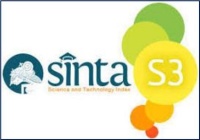Keanekaragaman dan Sebaran Tumbuhan Paku (Pteridophyta) di Desa Siraun, Kecamatan Kalumpang, Kabupaten Mamuju
Abstract
Keywords
Full Text:
PDFReferences
Arini, D. I. D., & Khino, J. (2012). Keragaman Jenis tumbuhan paku (Pteridophyta) di Cagar Alam Gunung Ambang Sulawesi Utara. Info BPK Manado, 2(1), 18–27.
Betty, J., Linda, R., & Lovadi, I. (2015). Inventarisasi jenis paku-pakuan (Pteridophyta) terestrial di hutan Dusun Tauk kecamatan Air Besar Kabupaten Landak. Protobiont, 4(1), 94–102.
Febrianti, W., Hasan, P. A., & Sari, A. P. (2022). Analisis Keanekaragaman Tumbuhan Paku di Desa Kondo Bulo, Kecamatan Kalumpang, Kabupaten Mamuju. Saintifik, 8(1), 63-68.
Hidayah, N., Julita, T., Melvinasari, M. W., Dwiyanoto, G., Ristanto, R. H., & Sigit, D. V. (2021). Identifikasi Pterydophyta di Hutan Kota Jakarta, Indonesia. Proceeding of Biology Education, 4(1), 1–11. https://doi.org/10.21009/pbe.4-1.1
Hutasuhut, M. A., & Febriani, H. (2019). Keanekaragaman Paku-Pakuan Terestrial Di Kawasan Taman Wisata Alam Sicike-Cike. Jurnal Biolokus, 2(1), 146-157.
Ismaini, L., Lailaty, M., Rustandi., & Sunandar, D. (2015). Analisis komposisi dan keanekaragaman tumbuhan di Gunung Dempo, Sumatera Selatan. Pros Sem Nas Masy Biodiv Indon, 1(6), 1397–1402.
Kirno, F., Dwi, A., & Ekamawanti, H. A. (2018). Keanekaragaman jenis tumbuhan paku-pakuan (Pteridophyta) dan kondisi tempat tumbuhnya pada Hutan Rawa Gambut Sekunder dan Lahan Gambut Terbuka. Jurnal Hutan Lestari, 7(1), 11–20.
Laely, S. N., Widyastuti, A., & Widodo, P. (2020). Keanekaragaman Tumbuhan Paku Terestrial di Cagar Alam Pemalang Jawa Tengah. BioEksakta: Jurnal Ilmiah Biologi Unsoed, 2(1), 116. https://doi.org/10.20884/1.bioe.2020.2.1.1966
Lindasari, W. F., Linda, R., & Lovadi, I. (2015). Jenis-Jenis Paku Epifit di Hutan Desa Beginjan Kecamatan Tayan Hilir Kabupaten Sanggau. Protobiont, 4(3), 65–73.
Praptosuwiryo, T. N., Sumanto, S., & Cahyaningsih, R. (2019). Diversity and host preferences of ferns and lycopods epiphytes on Palm Trees. Biodiversitas Journal of Biological Diversity, 20(12). https://doi.org/10.13057/biodiv/d201236
Ridhwan, M. (2012). Tingkat Keanekaragaman Hayati Dan Pemanfaatannya Di Indonesia. Jurnal Biology Education. 1(1), 1-17.
Sianturi, A. S. R., Retnoningsih, A., & Ridlo, S. (2020). Eksplorasi tumbuhan paku pteridophyta di wilayah ketinggian berbeda. LPPM Universitas Negeri Smearang: Semarang.
Siboro, D. T. (2019). Manfaat Keanekaragaman Hayati Terhadap Lingkungan. Jurnal Ilmiah Simantek, 3(1).
Simon, E. J., Dickey, J. L., Hogan, K. A., & Reece, J. B. (2015). Intisari Biologi. Erlangga.
Sirait, M., Rahmatia, F., & Pattulloh. (2018). Komparasi Indeks Keaenekaragaman Dan Indeks Dominansi Fitoplankton Di Sungai Ciluwung Jakarta. Jurnal Kelautan (Indonesia Journal of Marine Science and technology). 11(1), 75–79.
Surfiana, S., Kamal, S., & Hidayat, M. (2018). Keanekaragaman Tumbuhan Paku (Pteridophyta) Berdasarkan Ketinggian Di Kawasan Ekosistem Danau Aneuk Laot Kota Sabang. Prosiding Seminar Nasional Biotik, 5(1), 452-459.
Tourrohman, A, M., Surur, M. A., Nabila, R. E., & Rahmawati, S. D. (2020). Keanekaragaman Jenis Paku-Pakuan (Pteridophyta) dan Kajian Potensi Pemanfaatannya di Cagar Alam Ulolanang Kecubung. Bioeduscience, 4(1), 73–81.
Umair, M., Hu, X., Cheng, Q., Ali, S., & Ni, J. (2023). Distribution patterns of fern species richness along elevations the Tibetan Plateau in China: Regional differences and effects of climate change variables. Frontiers in Plant Science, 14. https://doi.org/10.3389/fpls.2023.1178603
Wahyuningsih, Triyanti, M., & Sepriyaningsih. (2019). Inventarisasi Tumbuhan Paku (Pteridophyta) di Perkebunan PT BINA Sains Cemerlang Kabupaten Musi Rawas. Jurnal Biosilampari. Jurnal Biologi, 2(1), 29–35.
DOI: https://doi.org/10.33394/bioscientist.v13i2.15855
Refbacks
- There are currently no refbacks.

This work is licensed under a Creative Commons Attribution-ShareAlike 4.0 International License.

Bioscientist : Jurnal Ilmiah Biologi is licensed under a Creative Commons Attribution-ShareAlike 4.0 International License
Editorial Address: Pemuda Street No. 59A, Catur Building Floor I, Mataram City, West Nusa Tenggara Province, Indonesia











